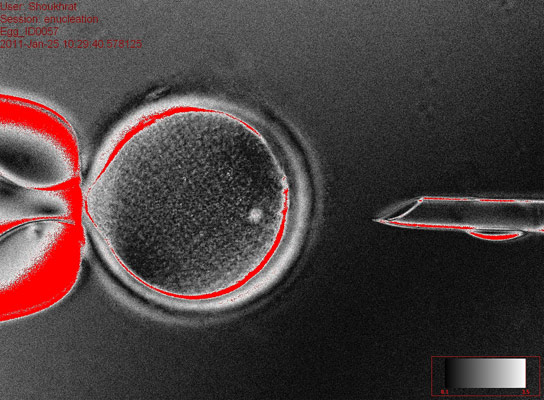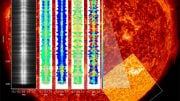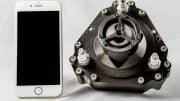
Donor egg cytoplasm containing skin cell nucleus. Credit: Oregon Health & Science University
Researchers at Oregon Health & Science University and the Oregon National Primate Research Center have successfully converted human skin cells into embryonic stem cells, marking the first time human stem cells have been produced via nuclear transfer.
Scientists at Oregon Health & Science University and the Oregon National Primate Research Center (ONPRC) have successfully reprogrammed human skin cells to become embryonic stem cells capable of transforming into any other cell type in the body. It is believed that stem cell therapies hold the promise of replacing cells damaged through injury or illness. Diseases or conditions that might be treated through stem cell therapy include Parkinson’s disease, multiple sclerosis, cardiac disease and spinal cord injuries.
The research breakthrough, led by Shoukhrat Mitalipov, Ph.D., a senior scientist at ONPRC, follows previous success in transforming monkey skin cells into embryonic stem cells in 2007. This latest research is published in the journal Cell, online on May 15 and in print on June 6.
The technique used by Drs. Mitalipov, Paula Amato, M.D., and their colleagues in OHSU’s Division of Reproductive Endocrinology and Infertility, Department of Obstetrics & Gynecology, is a variation of a commonly used method called somatic cell nuclear transfer, or SCNT. It involves transplanting the nucleus of one cell, containing an individual’s DNA, into an egg cell that has had its genetic material removed. The unfertilized egg cell then develops and eventually produces stem cells.
“A thorough examination of the stem cells derived through this technique demonstrated their ability to convert just like normal embryonic stem cells, into several different cell types, including nerve cells, liver cells and heart cells. Furthermore, because these reprogrammed cells can be generated with nuclear genetic material from a patient, there is no concern of transplant rejection,” explained Dr. Mitalipov. “While there is much work to be done in developing safe and effective stem cell treatments, we believe this is a significant step forward in developing the cells that could be used in regenerative medicine.”
Another noteworthy aspect of this research is that it does not involve the use of fertilized embryos, a topic that has been the source of a significant ethical debate.
The Mitalipov team’s success in reprogramming human skin cells came through a series of studies in both human and monkey cells. Previous unsuccessful attempts by several labs showed that human egg cells appear to be more fragile than eggs from other species. Therefore, known reprogramming methods stalled before stem cells were produced.
To solve this problem, the OHSU group studied various alternative approaches first developed in monkey cells and then applied to human cells. Through moving findings between monkey cells and human cells, the researchers were able to develop a successful method.
The key to this success was finding a way to prompt egg cells to stay in a state called “metaphase” during the nuclear transfer process. Metaphase is a stage in the cell’s natural division process (meiosis) when genetic material aligns in the middle of the cell before the cell divides. The research team found that chemically maintaining metaphase throughout the transfer process prevented the process from stalling and allowed the cells to develop and produce stem cells.
“This is a remarkable accomplishment by the Mitalipov lab that will fuel the development of stem cell therapies to combat several diseases and conditions for which there are currently no treatments or cures,” said Dr. Dan Dorsa, Ph.D., OHSU Vice President for Research. “The achievement also highlights OHSU’s deep reproductive expertise across our campuses. A key component to this success was the translation of basic science findings at the OHSU primate center paired with privately funded human cell studies.”
One important distinction is that while the method might be considered a technique for cloning stem cells, commonly called therapeutic cloning, the same method would not likely be successful in producing human clones otherwise known as reproductive cloning. Several years of monkey studies that utilize somatic cell nuclear transfer have never successfully produced monkey clones. It is expected that this is also the case with humans. Furthermore, the comparative fragility of human cells as noted during this study, is a significant factor that would likely prevent the development of clones.
“Our research is directed toward generating stem cells for use in future treatments to combat disease,” added Dr. Mitalipov. “While nuclear transfer breakthroughs often lead to a public discussion about the ethics of human cloning, this is not our focus, nor do we believe our findings might be used by others to advance the possibility of human reproductive cloning.”
Reference: “Human Embryonic Stem Cells Derived by Somatic Cell Nuclear Transfer” by Masahito Tachibana, Paula Amato, Michelle Sparman, Nuria Marti Gutierrez, Rebecca Tippner-Hedges, Hong Ma, Eunju Kang, Alimujiang Fulati, Hyo-Sang Lee, Hathaitip Sritanaudomchai, Keith Masterson, Janine Larson, Deborah Eaton, Karen Sadler-Fredd, David Battaglia, David Lee, Diana Wu, Jeffrey Jensen, Phillip Patton, Sumita Gokhale, Richard L. Stouffer, Don Wolf and Shoukhrat Mitalipov, 15 May 2013, Cell.
DOI: 10.1016/j.cell.2013.05.006
The human studies were funded by OHSU and a grant from Leducq Foundation. The nonhuman primate studies were funded by the following grants from the National Institutes of Health: HD063276, HD057121, HD059946, EY021214, and OD011092.









It is a process of reverse transcription of usual omnipotent cells transforming into pluripotent and then as multipotent cells. In embryonic stage the first proto cell of totipotent transforms into pluripotent and then as multipotent cells. Already cell lines were derived from human marrow stem cells to produce seperate nerve cells etc., instead of relying on placenta cells or human egg cells. This process is going down further from ordinary multipotent cells of skin to form cells of higher nature. This process will enable further in helping growth of organs and then transplanting same in humans without a donor in future medical processes. Thank You.